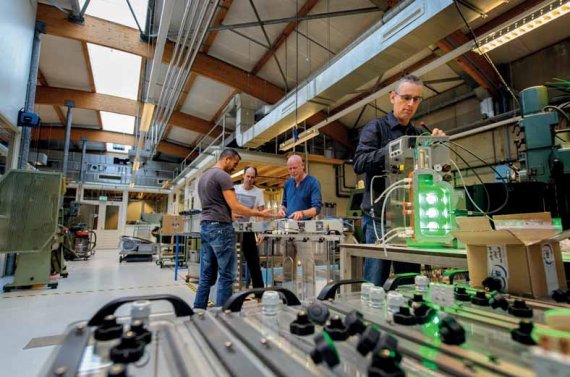Innovatron? You have probably never heard of it. You have to know what you are looking for, otherwise you would walk right past it. On the Bornse Weilanden behind Zodiac stands a big blue building next to a low embankment. A tiny sign at ankle height on the path to the entrance tells you this is the Development Workshop. So this is it. Building 121, the AFSG and ASG Development Workshop, recently redubbed Innovatron. It was Reinoud Hummelen, one of the two managers, who came up with the name. ‘We needed something appropriate and Latin-sounding. And there was already a Technotron, now Axis,’ he says almost apologetically. In fact, the name is quite apt as development and innovation are the core business. This is not the place for run-of-the-mill solutions, explains the other manager, Eric Karruppannan. ‘We don’t make things from a catalogue. We make equipment that isn’t on the market. We select the jobs we accept on that basis.’ That means prototypes, one-offs or short series, adds Hummelen. Not because they look down on the run-of-the-mill jobs, but because non-standard solutions are their stock in trade. Strange-looking equipment for teaching and research, like the algae breeding reactor Algaemist.
INNOVATRON
The Development Workshop was the result of the merger of the AFSG workshop (Biotechnion) and the ASG workshop (Zodiac) two years ago. Last autumn, it was officially rechristened Innovatron. There are nine specialists, working in electronics, process control engineering, construction and metalworking. ESG and PSG have similar (smaller) workshops of their own. Innovatron serves the entire campus, making complex equipment for teaching and research that is not available on the market. But researchers can also go there for basic technical problems, service and repairs. Innovatron is a non-profit organization and has an annual turnover of 800 thousand euros.
Green gold
Algaemist sounds like ‘Alchemist’ when pronounced in Dutch: Innovatron’s geeks are good at names. The breeding reactor is the key to green gold. The first device was developed in 2011 for teaching purposes. Marcel Janssen at Bioprocess Technology ordered 16 for a practical. ‘He came with a list of preferences and requirements, and asked if we could help.’ The striking thing about the Algaemist is the reactor vessel, which is flat rather than circular. Janssen came up with that idea himself. ‘Reactor vessels are normally round so that you can stir the contents. But we wanted a flat reactor that you can illuminate on one side. That makes the light measurements easier,’ says Janssen. That is important for lab experiments. Light is the engine that drives photosynthesis, the production mechanism within the algae. So the ‘vessel’ is actually a narrow space between two glass plates. But stirring is difficult with a flat surface, so that task is performed by bubbling air through it. An inflow of air enriched with carbon dioxide not only ensures a constant supply of the raw materials for photosynthesis but also takes away the oxygen that is formed, creates a flow and mixes the contents.
Commercial
The Algaemist has turned out to be a success in commercial terms too. They have now made about 50 such reactors, each one the price of a family car. Most of them can be found in the AlgaeParc and Bioprocess Technology. But algae researchers in Aquatic Ecology, the Netherlands Institute of Ecology and VHL Leeuwarden also use them. And thanks to PhD students and alumni, there are now Algaemists in Denmark, Norway and even Mexico. ‘We have pretty much set the standard for labmodel algae reactors,’ says Karruppannan with justified pride. ‘And that success means we are also able to develop the next generation of reactors.’ That next generation is currently under construction in the workshop. The key here is to scale up. The Algaemist is a table model with a reactor vessel capacity of 400 millilitres. They are now working on a larger version with 25 litres, still with flat reactors. But it is not really possible to scale it up further than that, says Janssen. The plates become too large and bend, while the water pressure in the reactor causes problems for the air flows. So the latest development, a production model, uses tubes instead of plates. The device takes up an area of 25 square metres and should be able to produce 150 kilos of dry matter a year.
We make equipment that isn’t on the market
Beer mat
This is turning out to be a formidable challenge for the Innovatron engineers. But that is precisely what they enjoy, says Karruppannan. ‘You need to be creative. If you aren’t, you end up with something that’s already on the market, probably costing less than what we can deliver. People often arrive with no more than an idea, a sketch. But all we need is some notes on a beer mat. Then we work with the customer to come up with a feasible, affordable piece of equipment. That’s the challenge. That’s when our eyes light up here. You have to be a bit of a technology freak.’
Photo: Guy Ackermans


